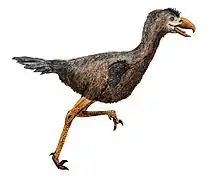Llallawavis
Llallawavis scagliai (magnificent bird of Scaglia) is a large, extinct predatory bird from Pliocene Argentina. Its fossil is the most complete fossil of a phorusrhacid (or "terror bird") yet found.
| Llallawavis | |
|---|---|
 | |
| Reconstructed skeleton | |
| Scientific classification | |
| Kingdom: | Animalia |
| Phylum: | Chordata |
| Class: | Aves |
| Order: | Cariamiformes |
| Family: | †Phorusrhacidae |
| Genus: | †Llallawavis Degrange et al., 2015[1] |
| Species: | †L. scagliai |
| Binomial name | |
| †Llallawavis scagliai Degrange et al., 2015[1] | |
Description

The fossil, discovered in 2010 in sediment among the cliffs above La Estafeta beach in the lower part of the Playa Los Lobos Allo Formation, contains the complete palate, complete trachea, skull, voice box, and eye bones. The fossil shows L. scagliai was a medium-sized phorusrhacid around 1.2 metres (3.9 ft) tall and lived in Argentina approximately 3.5 million years ago during the Pliocene.[1]
Habitat
Llallawavis scagliai likely roamed in grassland and weighed around 18 kilograms (40 lb).[2] The joints separating the skulls bones were fused, unlike modern birds, and that may have helped it batter prey. CT scans of its inner ear show that it could only hear frequencies between about 380 and 4230 hertz, and probably had a deep voice to match.[3]
The below cladogram is simplified after the analysis of Degrange et al. (2015).[1]
| Phorusrhacidae |
| ||||||||||||||||||||||||||||||
References
- Degrange, Federico J.; Tambussi, Claudia P.; Taglioretti, Matías L.; Dondas, Alejandro; Scaglia, Fernando (20 March 2015). "A new Mesembriornithinae (Aves, Phorusrhacidae) provides new insights into the phylogeny and sensory capabilities of terror birds". Journal of Vertebrate Paleontology. 35 (2): e912656. doi:10.1080/02724634.2014.912656.
- Perkins, Sid (9 April 2015). "New species of 'terror bird' discovered". Science. doi:10.1126/science.aab2465. Retrieved 2015-04-14.
- Webb, Jonathan (10 April 2015). "'Terror birds' had deep voices, fossil suggests". Science & Environment. BBC. Retrieved 2015-04-14.